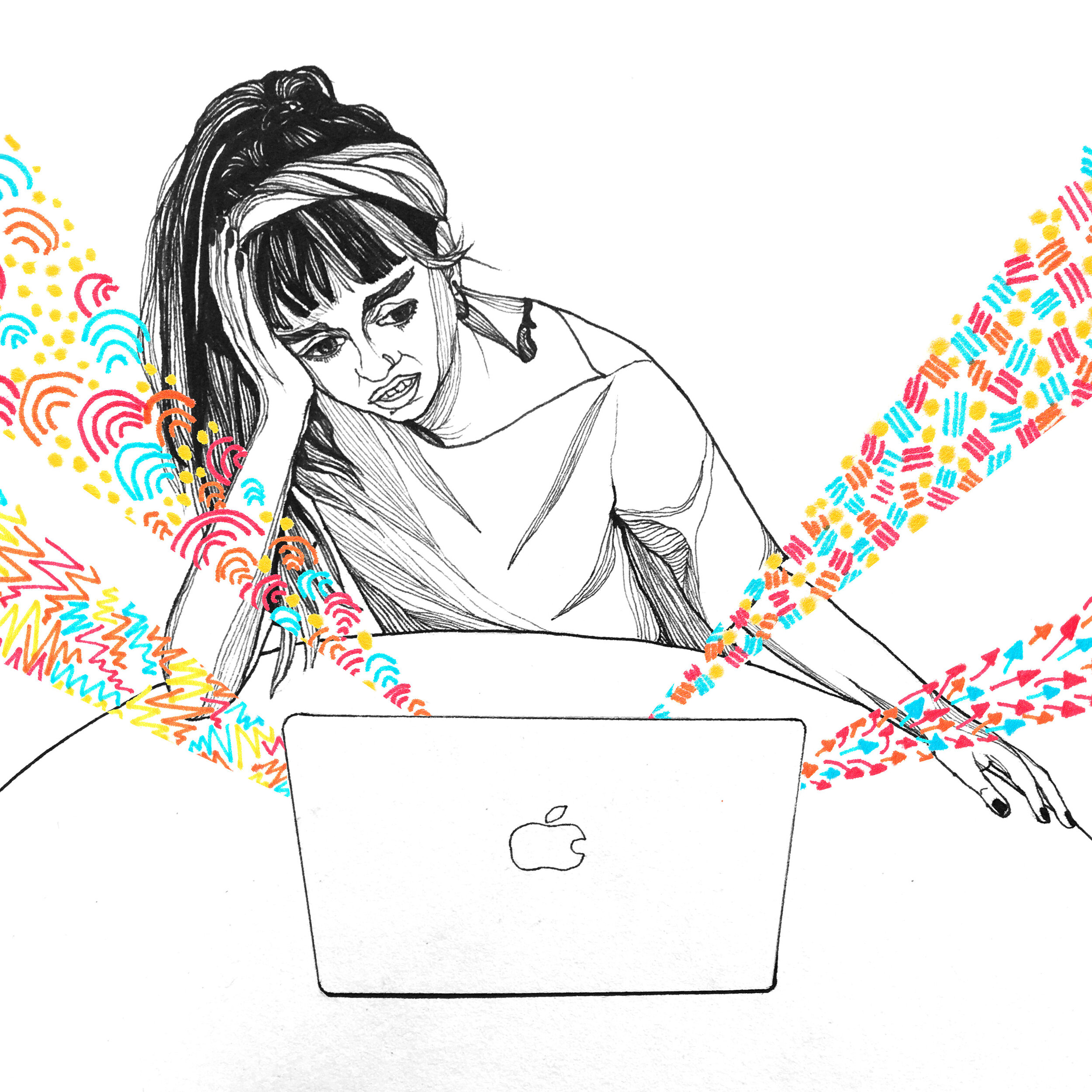Screens Compete with the Brain’s Innate Drive to Socialise
Plugged in (2020). Illustrations by Grace Holliday.
From giant storefront LED signs to devices that fit in the palm of your hand, we have assimilated screens of every kind. Yet from selfies that spoil the restorative effect of nature (1) to social media obsession that makes us lonelier than ever (2), screen intrusion can affect self-image, the way we communicate with one another, and even the way we feel (3).
How will upcoming generations fare when exposed to screens earlier and in more ways than ever before? A growing worry is that the insistent stimulation afforded by social media and screen exposure competes with the brain’s inherent networks for socialisation and emotional intelligence. That is, the high levels of stimulation coming from digital devices such as tablets embedded in bassinets, iPotty trainers, and the backs of car seats compete with the natural plasticity by which person–to–person experience forges new connections among neurons. During one’s early years, these connections are busy becoming brain networks for socialisation and emotional intelligence. Interfering with them likely has ill effects on daily life compared to earlier generations.
The Brain’s Drive to be Social
From an evolutionary perspective the human brain is inherently social. Infants instinctively read others long before they learn to speak. They can distinguish different facial expressions and what they mean. But external observations carry a mere fraction of the information that matters. Human observers are vastly more interested in inferring the mental states behind the observable shell—the other peson’s beliefs, desires, and intentions. The ability to infer and reason about another’s mental state is called “Theory of Mind.” Recently discovered regions in the human cortex selectively and specifically underlie this ability to infer another’s thoughts (4).
Later on during puberty another burst of social development takes place. But the process continues steadily, if less robustly, well into the late twenties. When real-world experiences are pushed aside by screen stimulation that emphasises sensation at the expense of critical thought, then we have conditioned ourselves to ‘socialise’ through texts and tech-at-a-distance rather than conducting it up close in person as we have done for a hundred thousand years.
The most pernicious influence of screen media is the way it competes with the brain’s innate instinct to socialise and consumes our fixed bandwidth of attention (5). Screens have made it difficult to be present—not just to others but also to oneself. Dinner with a friend is marked by constant interruptions. We clutch our phones and take them to the toilet, to the bed, to just about everywhere. Their constant presence shunts aside chances for spontaneous encounters, making it easier and more comfortable to relinquish attention to a screen than to make ourselves available to another. Psychologically, many people have such a strong emotional attachment to their phone that we can regard it as an extended iSelf. A robust attachment makes one susceptible to ‘nomophobia’, a word coined from the elision of ‘no mobile’ plus ‘phobia’ to describe the panic that arises from not having immediate access to one’s phone (6). The anxiety arises from elevated stress hormones cortisol, epinephrine, and norepinephrine.
Larry Rosen, Professor Emeritus at California State University, has studied the psychological effects of technology on adults, teens, and children for thirty years. One recent count has 18 to 24 year-olds checking their phones 210 times a day, or roughly once every five minutes. Rosen found that “heavy smartphone users showed increased anxiety after only 10 minutes” of not having access to their smartphone, an excellent description of nomophobia. During a one-hour experiment, the anxiety among heavy users shot up to self–reported “unbearable” levels (7). Furthermore, out-of-sight is not out-of-mind. “Unhealthy connection to their constant use weighs on users,” says Rosen, causing anxiety even when the device is out of view (8).
Network Competition
The first year of life is peak time for neural plasticity. The visual cortex, for example, develops its forest of connections most rapidly during the first three months of life, and the postnatal brain grows in volume by one percent every day, tripling in size between ages 0–2. The influence of early experience is therefore particularly important, and critical time windows exist during which a specific type of input (e.g., vision, hearing) has its greatest effect on brain development. Patterns of synaptic connections establish themselves by repeated sensory simulation and actions. However, a reversal of connections already laid down can happen when expected stimulation is absent, or if competition from other experiences such as a tablet thrust before a baby’s face blocks it.
Until the iPad’s appearance in 2010, other humans were almost certainly the most interesting thing in a baby’s world. Broadcast television is 70 years old; exposure to close-up screen media during the first three years of life has only penetrated the culture in the past decade or so. Occasions for screen viewing today, whether voluntary or forced upon us, are everywhere. Although not strictly zero-sum, competition with screen media is typical of brain development in general, in that a gain in one place exacts a loss somewhere else. Sights and sounds coming from a screen may not mean much, if anything, to a child, but the constant stimulation bolsters basic sensory pathways at the expense of more complex ones destined to mature into networks for social intelligence and engagement.
Consider the ‘still face’ paradigm. Using smart devices in front of their children makes a parent temporarily unavailable, and their psychological disappearance affects the child’s emotional attachment. The still face paradigm consists of three phases: mutual free play between mother and child; the still face phase during which the mother is physically present but stares down at her phone and neither responds to nor initiates any bids for attention; and a reunion phase that restores the parent as fully engaged and emotionally available.
When physical or vocal attempts to gain a parent’s attention go unanswered, children become distressed. In the lab, the mother is instructed to scroll, type, and focus on her phone for just two minutes—the still face phase. Mum may think that checking takes only a second, but kids see it differently, as the video of the experiment reveals. Behavioral psychologist Dr. Tracy Dennis-Tiwari urges parents to understand that face-to-face engagement is the most important time during which to give children emotional feedback and tune in to their needs. “These quality interactions aren’t just icing on the cake in terms of how young children learn about themselves and the world. It is the cake” (9).
In previous generations telephones were either bolted to a wall or tethered to the kitchen counter (and they didn’t have an attention-grabbing screen). Mum could signal with a look or gesture that she’d be with you in a minute. She made eye contact while she dealt with whoever was on the line and held it reassure you. But today when a child sees mum’s head looking down, there is no telling how long it will be before she looks up again at you. The final reunion phase of the still face experiment provides an opportunity for mother and child to reconnect emotionally. Unfortunately, the more habitually preoccupied a parent is with her screen, the less successful reunion is at repairing the emotional breech that the device itself creates (10, 11).
Effect on daily life
In its effect on daily life, the screen world has no precedent. Previously, the car enabled easy movement from place to place; the fridge and microwave revolutionised meal preparation; the TV (initially available only on a fixed-schedule each evening) provided vivid escapism that was nonetheless rooted in the real world. People ate dinner together, argued and laughed together, shopped face to face, worked in close proximity, recreated, played games, and dated in a common physical space. Earlier technologies were a means to an end to make daily life better.
Today it is normal to wake up, work, shop, entertain yourself, and seek out sex without physically interacting with another person for the entire day. After lighthouse keeper, a writer has the second most solitary occupation. If I haven’t socialized in person today then I make it a point to call someone close to me before the close of day. Social media isn’t social at all; I need to hear their voice, full of nuance and meaning, and I believe they benefit from hearing mine. And then I turn off my devices until morning. Otherwise I let the screen world become not a means but the end in itself.
Richard E. Cytowic, MD MFA, Professor of Neurology at George Washington University, is best known for bringing synesthesia back to mainstream science. His short compendium Synesthesia is part of MIT Press’s Essential Knowledge Series, and Wednesday Is Indigo Blue received the Montaigne Medal. This essay is adapted from his forthcoming book, Digital Distractions: Your Stone–Age Brain on Screens & How They Kill Your Social Skills. @Cytowic & https://Cytowic.net
References
1) Cytowic, R.E (2019) When you trample nature for the sake of a selfie, you lose. Psychology Today. Available online.
2) Cytowic, R.E (2020) Does Loneliness Eat at You? Screen Media May be to Blame. Psychology Today. Available online.
3) Gazzaley, A. and L.D. Rosen (2016) The distracted mind: ancient brains in a high-tech world. Cambridge, MA: MIT Press
4) Richardson, H., et al (2018) Development of the social brain from age three to twelve years. Nature communications 9(1): p. 1-12
5) Cytowic, R (2014) What Percentage of Your Brain do you Use? TED-Ed: Lessons Worth Sharing, 2014. Available online.
6) King, A., et al. (2014) Nomophobia: Dependency on virtual environments or social phobia? Computers in Human Behavior, 29: p. 140-144
7) Rosen, L (2015) Is Technology Making People Less Sociable? Wall Street Journal, p. R4. Available online.
8) Cheever, N.A., et al (2014) Out of sight is not out of mind: The impact of restricting wireless mobile device use on anxiety levels among low, moderate and high users. Computers in Human Behaviour. 37: p. 290-297
9) Sawyer, D (2019) Screentime: Parents see impact of screen time on babies, toddlers. Good Morning America. See also, and also, plus personal communication with Dr Dennis–Tiwari.
10) Myruski, S., et al (2017) Digital disruption? Maternal mobile device use is related to infant social‐emotional functioning. Developmental science. 21(4): p. e12610. doi: 10.1111/desc.12610.
11) Myruski, S (2018) Biological Signatures of Emotion Regulation in Children. CUNY Academic Works. Available online.







